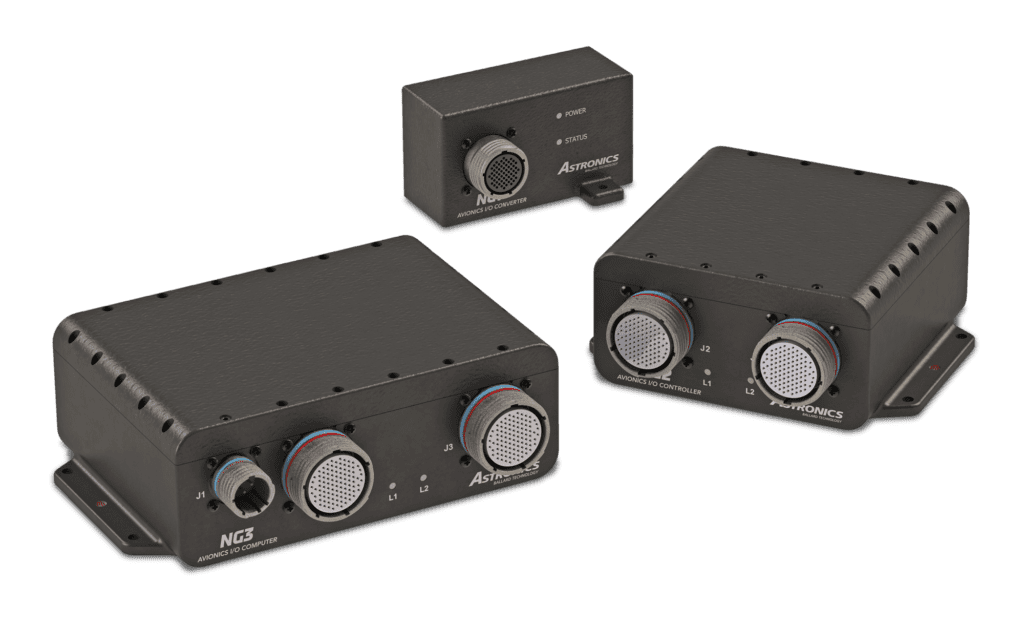
Astronics new NG1, NG2 and NG3 comprise its next generation of Ballard embedded avionics input/output computing. Photo: Astronics Corp.
Astronics Ballard is embedding an open architecture with a 64-bit processing foundation and Ethernet backbone across its next generation of NG avionics input/output (I/O) computers.
The New York-based manufacturer unveiled the NG1, NG2 and NG3 I/O avionics interfacing and computing boxes as an upgrade to its existing AB2000 and AB3000 systems on Nov. 7. Inside the next generation boxes are simple converters capable of supporting Ethernet, MIL-STD-1553 and ARINC 429 among other data bus protocols, and the type of processing capable of enabling advanced distributed control and mission computing on fighter jets, drones and helicopters.
While the NG3 and NG2 are described as providing high I/O and audio/video enablement for avionics applications, NG1 is designed to convert avionics protocol data to Ethernet and interfacing the NG3 and NG2 to other avionics systems within an aircraft’s network. Jon Neal, President of Astronics Ballard Technology, told Avionics International a key enabler of the NG computers is the use of 64-bit processing to allow developers to create more complex application software capable of handling higher levels of multi-tasking.
Among other features embedded in the NG avionics are user removable solid state drive media and a mini peripheral component interconnect express (PCIe) expansion slot. Neal also provided some examples of future military avionics applications and functionality the NG boxes can support.
“For example, several NG1 converters could be used near clusters of sensors to convert this data to Ethernet for input to a controller upstream. An NG3 could be used to aggregate and control all of the various I/O in a surveillance pod attached to a UAV and communicate directly with the main mission computer on the craft,” Neal said.
Other use cases include the use of NG devices to gather aircraft positional data from control data buses in order to “accurately align a satellite communications antenna for reliable communication with satellites, using NG devices to manage MIL-STD-1553 signals for radio control of ARC-210 military radios or adding NG devices to provide Ethernet switch expansion to mission computers in a distributed system,” according to Neal.

NG1 is the smallest form factor of the new boxes, designed for converting avionics protocol data to Ethernet for interfacing to the NG3/NG2 or other avionics systems.
All three NG variants are also designed to support the Department of Defense’s (DoD) focus on using open architecture computing in future aircraft and ground embedded systems upgrades. In January, U.S. Air Force, Army and Navy officials signed a memorandum agreeing that future acquisitions of new aircraft technologies will focus on using the Modular Open Systems Approach (MOSA). In addition to MOSA, the NG computers also meet the design requirements for DoD’s Open Mission Systems (OMS) standard.
Optimization of size, weight and power (SWAP) was included in the development of the NG computers.
“The NG3 Series product is a direct size and mounting replacement for the existing AB3000. This was intentional to provide an easier physical upgrade path that not only allows a user to move to 64-bit processing and other security functions, but also gain other new features such as higher I/O channel counts, Gigabit Ethernet switch, and removable mSATA solid-state drives,” Neal said.
“The NG2 Series is more than 25 percent smaller and lighter than the AB3000 and is also slightly smaller than the AB2000,” he added.
Astronics is already taking orders for NG3, while the NG2 and NG1 will become available in 2020.